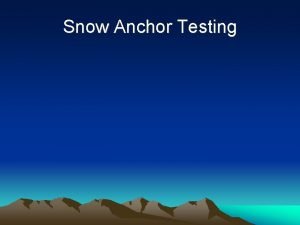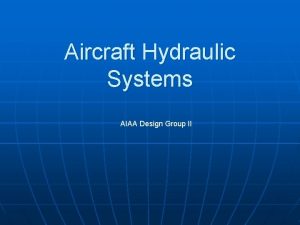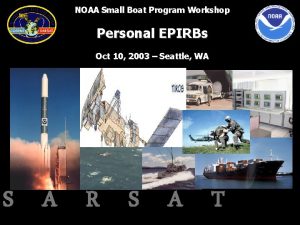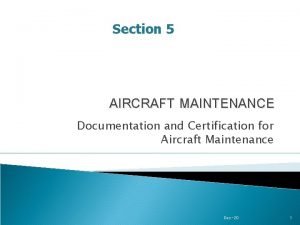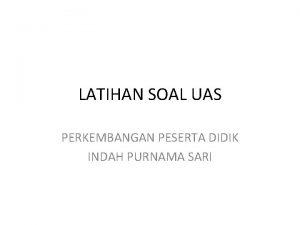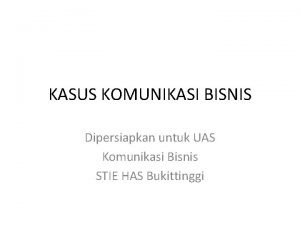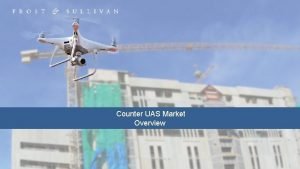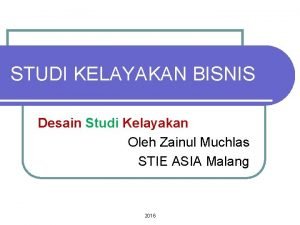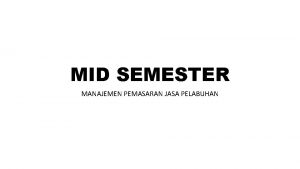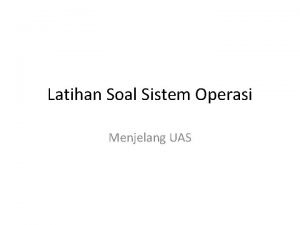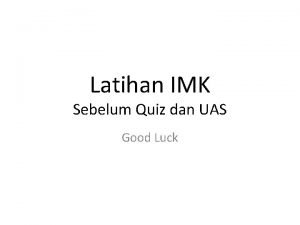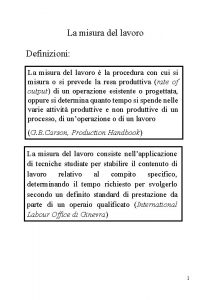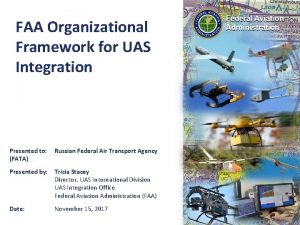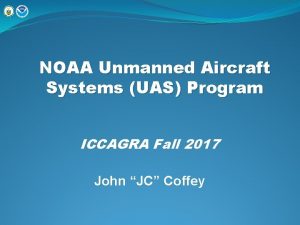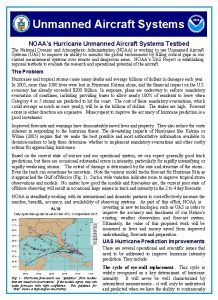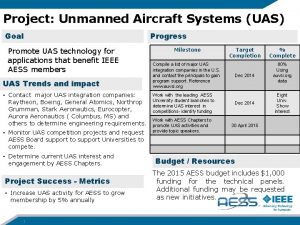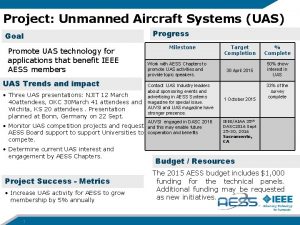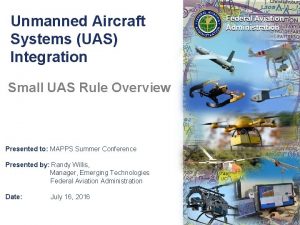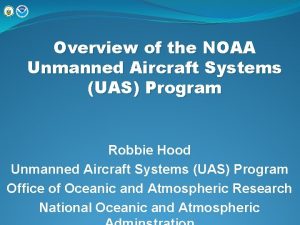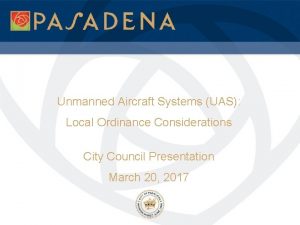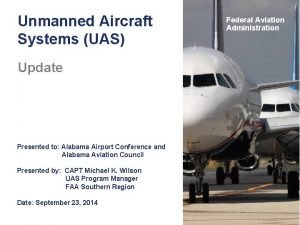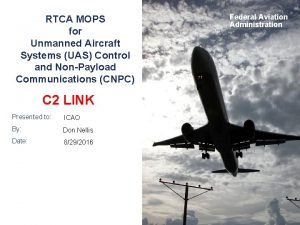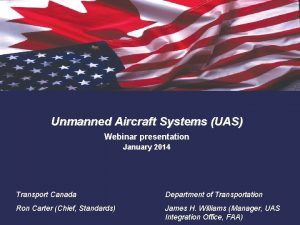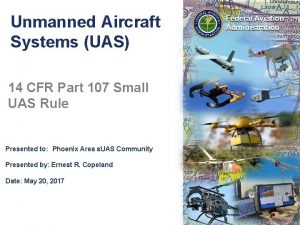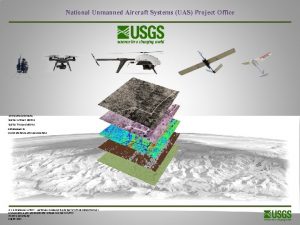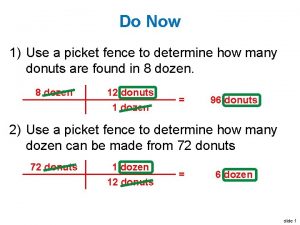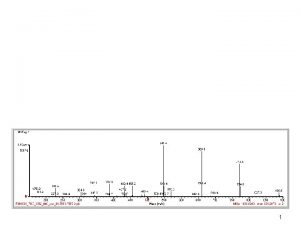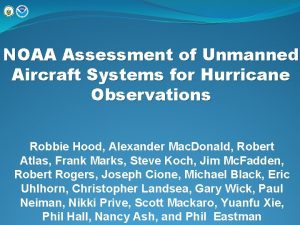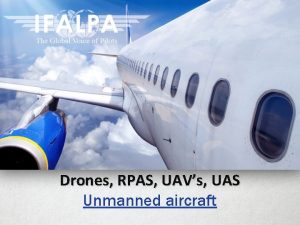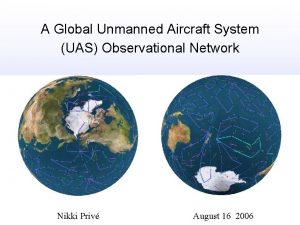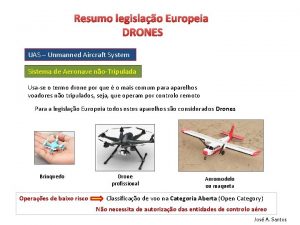NOAA Unmanned Aircraft Systems UAS Program Picket Fence


























- Slides: 26

NOAA Unmanned Aircraft Systems (UAS) Program “Picket Fence” CONOPS Briefing to NOAA Air Resources Laboratory / Oak Ridge, TN 11 March 2015

NOAA UAS “Picket Fence” Schematic

NOAA UAS “Picket Fence” Schematic Phase 1: VTOL Network Phase 2: Fixed Wing Fleet

NOAA UAS “Picket Fence” Schematic CAL/VAL Sites Phase 1: VTOL Network Phase 2: Fixed Wing Fleet

NOAA UAS “Picket Fence” Objectives Objective #1: Obtain high temporal/spatial resolution Meteorological Observations of lower atmosphere (emphasis on the planetary boundary layer) q Near real-time operational forecaster Decision Support System (DSS) examination q Input for high-resolution Numerical Weather Prediction (NWP) forecast models Objective #2: Obtain high temporal/spatial resolution Air Quality Observations of lower atmosphere for improved analysis and transport/dispersion forecasting Objective #3: Rapid Response surveillance / Storm Damage Assessment 5

NOAA UAS “Picket Fence” Objectives Objective #1: Meteorological Observations Current Upper Air Observation Network -Full Tropospheric Soundings -BUT… Sparse network -AND… Usually only 2 x per day! 6

NOAA UAS “Picket Fence” Objectives Objective #1: Meteorological Observations Current Upper Air Observation Network Very Sparse Coverage ! -Full Tropospheric Soundings -BUT… Sparse network -AND… Usually only 2 x per day! 7

NOAA UAS “Picket Fence” Objectives Objective #1: Meteorological Observations Picket Fence Regional Network: Central Tennessee Valley Example Current Upper Air Observation Network -Full Tropospheric Soundings -BUT… Sparse network -AND… Usually only 2 x per day! -Lower 1/2 Tropospheric Soundings -BUT… Dense network -AND…Frequency > 1 x per hour! 8

NOAA UAS “Picket Fence” Objectives Objective #2: Air Quality Observations q Focus on observing concentrations of pollution in the lower atmosphere. q Combine in-situ observations with information retrieved from the NASA Tropospheric Emissions: Monitoring of Pollution (TEMPO) geostationary satellite, which is set to launch around 2017…Synergistically capitalize on the accuracy of local in-situ UAS-based air quality measurements with the broader regional coverage of TEMPO retrievals. 9

NOAA UAS “Picket Fence” Objectives Objective #3: Rapid Response / Storm Damage Assessment Aerial photo showing the remains of homes hit by a massive tornado in Moore, OK on May 20, 2013. (AP Photo/Steve Gooch) / AP 10

NOAA UAS “Picket Fence” Regions of Interest Regions: Alabama Oklahoma Mississippi Colorado Tennessee Missions: § Severe/Winter Weather Prediction § Air Quality § Rapid Response / Severe Storm Damage Assessment 11

Picket Fence in Support of NSSL’s Tempest UAS CONOPS for CI Missions 50 -60 mi between Mesonet sites § § Target locations for CI, e. g. , drylines Non-stop site-to-site flights for short baselines Staggered deployment for long baselines Mobile ground stations for fewer vehicles Slide provided by Dr. Steve Koch (NOAA NSSL) 12

NOAA UAS “Picket Fence” Regions of Interest Region: Florida Missions: • Land-falling tropical system sampling and prediction • Enhanced “Sea Breeze” Thunderstorm Prediction • River Forecasting Center Assessments • Air Quality • Hurricane and Severe Storm Damage Assessment 13

NOAA UAS “Picket Fence” Regions of Interest Region: North Carolina Missions: • Fire Weather Boundary Layer Climatology / Prediction • Land-falling tropical system sampling and prediction • Air Quality • Hurricane and Severe Storm Damage Assessment 14

NOAA UAS “Picket Fence” Regions of Interest Region: California Missions: • Marine Layer Prediction / Energy Forecasting • Air Quality • Fire and Fire Weather • Land Slide and Burn Scar Assessment • Rapid Response / Damage Assessment 15

NOAA UAS “Picket Fence” Regions of Interest Region: Alaska Missions: • Weather Measurements and Prediction • River Forecasting and Coastal Erosion • Air Quality • Oil Spill & Marine Debris • Rapid Response / Damage Assessment 16

“Picket Fence” Existing Collaborators 0 Concept Collaborators: NOAA – OAR NOAA – NWS (AK, AL, CA, CO, FL, MS, OK, TN) NOAA – NSSL NOAA - ARL Severe Weather Institute – Radar and Lightning Laboratory (SWIRLL) North Gulf Institute (NGI) University of Alabama at Huntsville University of Alaska - Fairbanks University of Colorado Mississippi State University Oklahoma State University of Oklahoma Vanderbilt University North Carolina State University 17

NOAA UAS Program Office “Picket Fence” CONOPS Questions? 0 18

NOAA UAS “Picket Fence” Proposed Observational Requirements Phase 1: VTOL UAS Platform: a) Data --Temperature --Humidity --Wind Speed --Wind Direction --Pressure --Air Quality, O 3, NO 2, actinic flux (sunlight) --EO/IR Video b) Accuracy of Data for Potential Sensors --Temperature: +/- 0. 2 C --Humidity: +/- 5% RH --Wind Speed: +/- 0. 5 m/s --Wind Direction: +/- 5 degrees azimuth --Pressure: +/- 1. 0 h. PA --Air Quality: +/- 5. 0 ppbv O 3, ± 0. 5 ppbv NO 2; 2% actinic flux --Video: “Reasonable” quality video (at least 5 MP) for opportunistic preliminary damage assessments c) Sensor Response Time (Atmospheric and Air Quality) -- Less than 5 seconds d) Altitude range --Surface to 6, 000 m 19

NOAA UAS “Picket Fence” Proposed Observational Requirements Phase 1: VTOL UAS Platform (…Continued): e) Vertical Data Resolution -- 10 m for air quality measurement operations -- 25 m for meteorological measurement operations f) Horizontal range --10 km g) Max Frequency of Deployments/Flights --One deployment per hour h) Operating Condition Ranges --Wind Speed: 45 m/s --Temperature: – 30 to +40 degrees C --Humidity: 0 -100% RH --Ongoing precipitation / Types: All weather i) Endurance --Minimum of 1 hour j) Acceptable Drift Radius (for Vertical Column Measurements) --Conical aspect ratio less than 10 degrees (upward from surface) k)_Ascent Rate --Ranging from 1 to 5 m/s, but ultimately dependent on sensor response / hysteresis 20

NOAA UAS “Picket Fence” Proposed Observational Requirements Phase 2: Fixed Wing UAS Platform: a) Data --Temperature --Humidity --Wind Speed --Wind Direction --Pressure --Air Quality, O 3, NO 2, actinic flux (sunlight) --High resolution georectified imagery b) Accuracy of Data for Potential Sensors --Temperature: +/- 0. 2 C --Humidity: +/- 5% RH --Wind Speed: +/- 0. 5 m/s --Wind Direction: +/- 5 degrees azimuth --Pressure: +/- 1. 0 h. PA --Air Quality: +/- 5. 0 ppbv O 3, ± 0. 5 ppbv NO 2; 2% actinic flux --Video: Very high resolution (at least 16 MP) images/video for damage assessments Georectfication fidelity within 10 cm c) Sensor Response Time (Atmospheric and Air Quality) -- Less than 5 seconds d) Altitude range --Surface to 6, 000 m 21

NOAA UAS “Picket Fence” Proposed Observational Requirements Phase 2: Fixed Wing UAS Platform (…Continued): e) Vertical Data Resolution -- N/A f) Horizontal range --1, 000 km g) Max Frequency of Deployments/Flights --Minimum of one extended deployment per day h) Operating Condition Ranges --Wind Speed: 55 m/s --Temperature: – 30 to +40 degrees C --Humidity: 0 -100% RH --Ongoing precipitation / Types: All weather i) Endurance --Minimum of 8 hours 22

NOAA National Weather Service Weather Forecast Offices Number of Nation-wide WFOs: 122

National Estuarine Research Reserve System (NERRS) NERRS Footprint: 28 Reserves (22 States + Puerto Rico)

Office of National Marine Sanctuaries Number/Area of Protected Domains: 14 regions / 170, 000 square miles

United States Coast Guard Number of Districts/Regions: 9 districts /17 regions
 Picket fence method
Picket fence method Picket fence method examples
Picket fence method examples Mastoid reservoir sign meaning
Mastoid reservoir sign meaning Picket fence federalism definition
Picket fence federalism definition Picket fence federalism definition
Picket fence federalism definition Unmanned space probes
Unmanned space probes Bides definition macbeth
Bides definition macbeth Security fence trinidad
Security fence trinidad Yates snow picket
Yates snow picket Picket fences
Picket fences Aircraft hydraulic systems
Aircraft hydraulic systems Noaa small boat program
Noaa small boat program Aircraft maintenance manual
Aircraft maintenance manual Uas perkembangan peserta didik
Uas perkembangan peserta didik Kasus komunikasi bisnis
Kasus komunikasi bisnis Dermografometro
Dermografometro Counter uas market
Counter uas market Contoh kasus aspek sdm dalam studi kelayakan bisnis
Contoh kasus aspek sdm dalam studi kelayakan bisnis Soal dan jawaban manajemen pemasaran jasa
Soal dan jawaban manajemen pemasaran jasa Warih puspitasari
Warih puspitasari Proses disebut konkuren apabila proses tersebut
Proses disebut konkuren apabila proses tersebut Quiz interaksi manusia dan komputer
Quiz interaksi manusia dan komputer Uas kecerdasan buatan
Uas kecerdasan buatan Musculoskeletal icd 10 codes
Musculoskeletal icd 10 codes Mtm uas tabelle
Mtm uas tabelle Faa afs org chart
Faa afs org chart Subes uas
Subes uas








